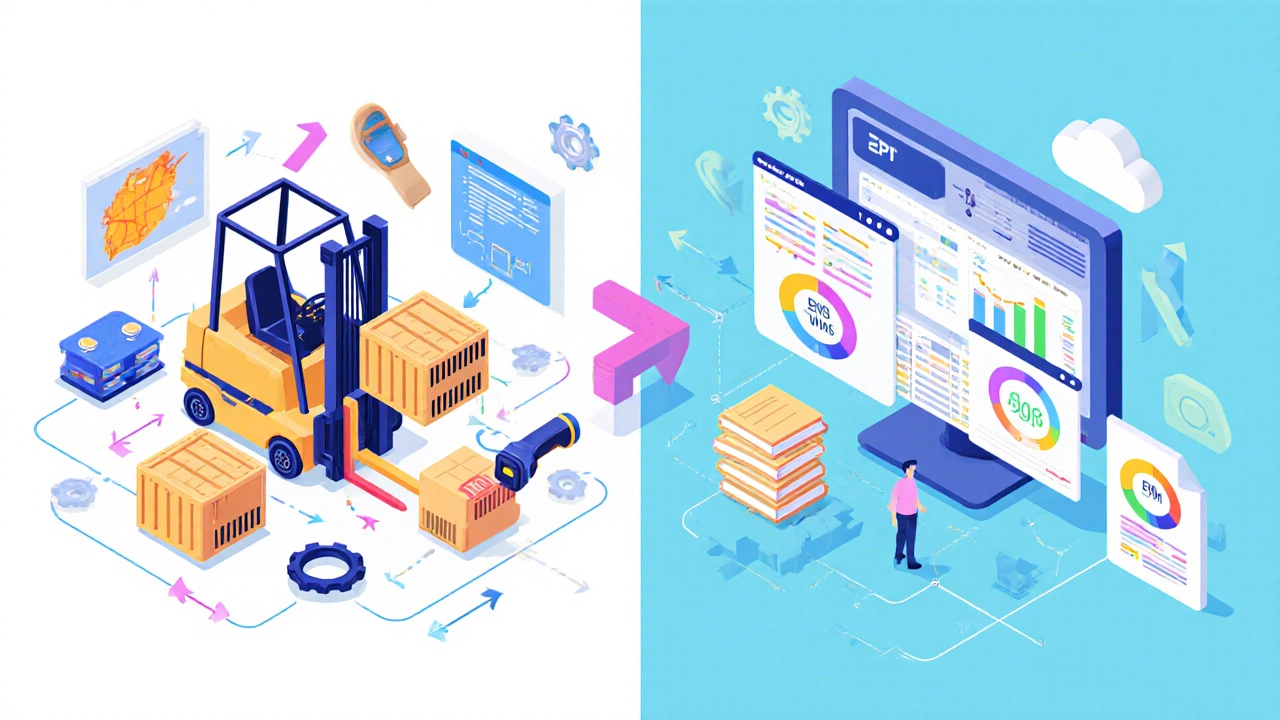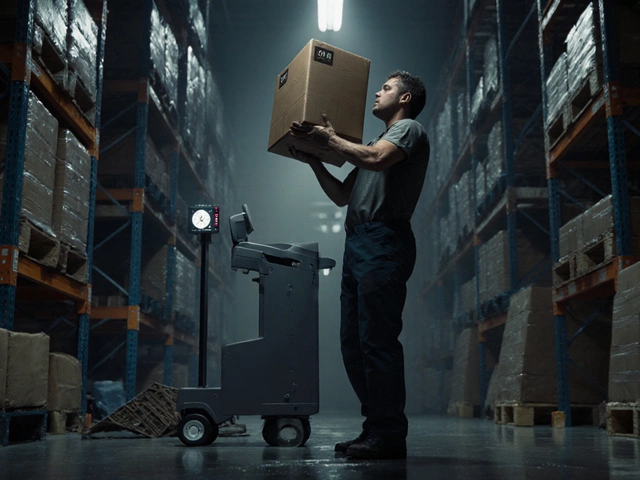When you hear the buzzwords WMS is a Warehouse Management System that focuses on optimizing daily warehouse operations such as receiving, put‑away, picking, and shipping. In contrast, ERP stands for Enterprise Resource Planning and is a broad suite that integrates finance, HR, manufacturing, procurement, and more across the whole company. Understanding where each system shines, where they overlap, and how they can work together is crucial for anyone looking to streamline logistics, cut costs, or scale a business.
Why the distinction matters
Choosing the right software stack often decides whether a warehouse runs like a well‑tuned assembly line or a chaotic parking lot. A WMS can give you centimeter‑level slotting accuracy, real‑time inventory counts, and labor efficiency metrics. An ERP, on the other hand, ties those warehouse metrics to financial reporting, purchase orders, and customer invoicing. Miss the link and you end up with data silos, duplicate entry, and delayed decision‑making.
Core functions of a WMS
- Inventory visibility: Real‑time location tracking down to the SKU level.
- Order fulfillment: Automated pick‑paths, wave planning, and wave release.
- Labor management: Task assignment, performance dashboards, and overtime alerts.
- Receiving & put‑away: Dock appointment scheduling, quality checks, and slot optimization.
- Shipping: Carrier selection, label generation, and proof‑of‑delivery capture.
Most modern WMS platforms sit in the cloud, offering APIs that push data to downstream systems. They often include Barcode Scanning and RFID support, making physical movements virtually error‑free.
Core functions of an ERP
- Financial accounting: General ledger, accounts payable/receivable, and multi‑currency handling.
- Procurement: Purchase order creation, supplier‑performance tracking, and contract management.
- Human resources: Payroll, benefits, and workforce planning.
- Manufacturing execution: Production scheduling, Bill of Materials (BOM) explosion, and shop‑floor data capture.
- Customer relationship management: Sales orders, quotations, and after‑sales support.
Like a central nervous system, an ERP pulls data from every department, enabling consolidated reporting and compliance across tax jurisdictions, IFRS, or GAAP.
Where they overlap
Both systems touch inventory, but they view it through different lenses. A WMS sees inventory as a physical asset that must be stored and moved efficiently. An ERP sees inventory as a financial asset that must be valued, costed, and reported.
Because of that overlap, many vendors now bundle a basic WMS module inside their ERP suite (e.g., Microsoft Dynamics 365 Supply Chain Management). However, specialized WMS solutions often out‑perform bundled modules on speed, scalability, and advanced features such as wave planning or cross‑dock automation.

Integration patterns
When a company needs the depth of a dedicated WMS and the breadth of an ERP, the two systems are typically linked through one of three patterns:
- Point‑to‑point API: Custom code pushes transactions (receipts, picks, shipments) from WMS to ERP in near real‑time.
- Middleware / ESB: An integration platform (e.g., MuleSoft, Dell Boomi) transforms messages, handles retries, and enforces data quality.
- iPaaS (Integration Platform as a Service): Cloud‑native connectors that require minimal coding, ideal for SaaS‑first warehouses.
Regardless of the method, the key is to establish a single source of truth for inventory quantity, location, and valuation. A mismatch of even a few units can cascade into costly stock‑outs or over‑stock situations.
Decision checklist: When to buy a dedicated WMS, an ERP, or both
| Criteria | WMS (dedicated) | ERP (built‑in module) | Full Integration (both) |
|---|---|---|---|
| Primary goal | Warehouse efficiency & labor productivity | Company‑wide financial & operational consolidation | Best of both worlds |
| Implementation time | 3-6 months (focus) | 6-12 months (full suite) | 12-18 months (complex integration) |
| Scalability | High - designed for thousands of SKUs, multiple sites | Moderate - depends on ERP’s warehouse module depth | Highest - combine strengths |
| Cost (annual) | $30 k-$150 k (license + support) | $100 k-$500 k (full ERP bundle) | +$200 k (integration & licensing) |
| Typical users | Warehouse managers, pick‑path planners | CFOs, procurement officers, HR leads | Executive team needing end‑to‑end visibility |
If your operation is under 10,000 SKUs and you already run an ERP, start by testing the ERP’s built‑in warehouse module. If you find bottlenecks-slow pick times, high labor cost per order-consider a dedicated WMS and integrate it via API.
Real‑world examples
Case A - Mid‑size e‑commerce retailer: The company used a generic ERP module for inventory. Order‑to‑ship time averaged 48 hours. After adding a cloud‑based WMS with wave planning, the average dropped to 26 hours and labor cost fell 15 %.
Case B - Global manufacturer: Their ERP already handled finance, procurement, and production. However, their sprawling distribution network suffered from inaccurate slotting. Implementing a specialized WMS that integrated via iPaaS gave them real‑time location data, which the ERP used to automatically adjust cost of goods sold (COGS) based on true inventory holding.

Pitfalls to avoid
- Duplicate data entry: If the WMS and ERP don’t talk, staff will manually reconcile spreadsheets-an error‑prone process.
- Choosing the cheapest option: A low‑cost WMS may lack the API standards needed for seamless ERP integration, leading to future expenses.
- Under‑estimating change management: Both systems introduce new workflows. Training, SOP updates, and stakeholder buy‑in are as important as the software itself.
- Ignoring scalability: A WMS that can’t handle multi‑site expansion will force a costly migration later.
Future trends
Artificial intelligence is weaving into both realms. Predictive demand algorithms, embedded in ERP, can feed replenishment signals directly to the WMS, which then optimizes slotting in anticipation of the next wave. Similarly, warehouse robots and voice‑directed picking are increasingly driven by WMS APIs, demanding tighter, low‑latency integration.
Another trend is the rise of “single‑source” SaaS platforms that promise both ERP and WMS capabilities under one roof. While appealing, they often trade depth for breadth. Companies should evaluate whether the platform’s roadmap aligns with their long‑term logistics strategy.
Frequently Asked Questions
Do I need both a WMS and an ERP?
It depends on the size and complexity of your business. Small companies often start with an ERP that includes basic warehouse features. As order volume, SKU count, or site count grows, a dedicated WMS adds the granularity needed to keep labor costs low and service levels high.
Can I replace my ERP with a WMS?
No. A WMS manages physical movement; an ERP handles finance, HR, procurement, and more. Replacing an ERP with a WMS would leave you without essential back‑office functions.
What integration method is best for real‑time data?
A point‑to‑point API or a modern iPaaS provides near‑real‑time synchronization. Middleware adds robustness, especially when you have multiple systems (e.g., TMS, CRM) in the mix.
How much does a dedicated WMS cost?
Licensing can range from $30 k for a basic cloud solution to $150 k+ for enterprise‑grade platforms with advanced automation. Implementation services and training add 20‑30 % on top of the license fee.
Is a cloud‑based WMS safer than on‑premise?
Cloud providers typically offer stronger disaster‑recovery, automated updates, and compliance certifications (ISO 27001, SOC 2). However, you must evaluate data residency requirements if you operate in regulated markets.





